Making authentic Thai yellow curry paste is more simple than it sounds. The bright yellow color with the bold taste of the curry paste requires a few aromatic spices, fragrant herbs, and Thai seasonings to give your homemade paste the most delicious and fresh for your Thai curry recipes.
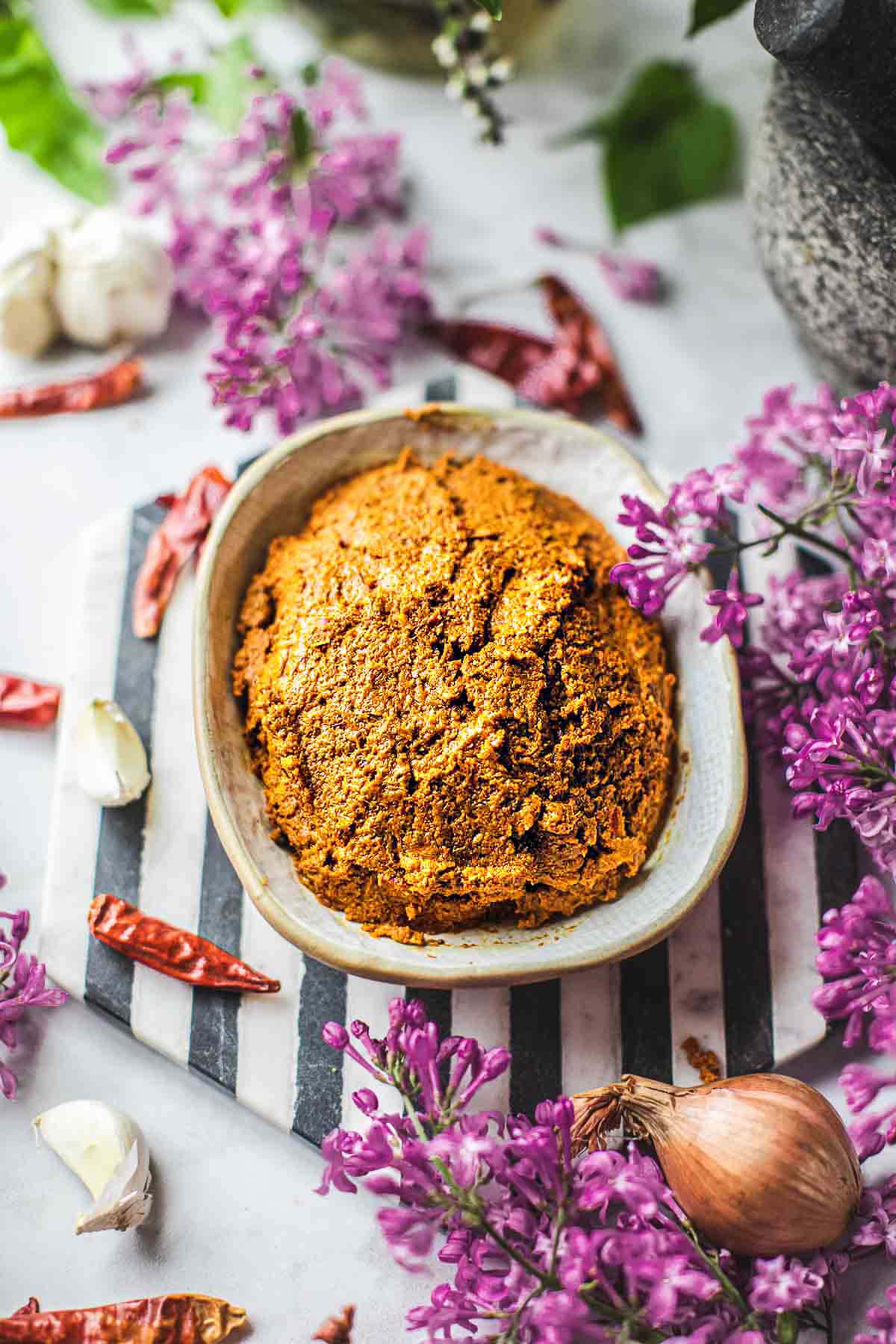
After making this amazing Thai yellow curry paste, make sure to use it to make these delicious Thai yellow curries that you will love! Thai pork belly with yellow curry and this super easy Thai yellow curry chicken. Both are unique and tasty in their own right!
Jump to:
- Why This Recipe Works
- More homemade Thai curry pastes to try
- What is yellow curry paste made of?
- What are the ingredients in Thai yellow curry paste?
- HOW TO MAKE AUTHENTIC THAI YELLOW CURRY PASTE
- Helpful Kitchen Notes
- More homemade curry pastes you'll love
- Variations
- Storage
- Substitution
- FAQs
- More Thai curries you'll love!
- Authentic Thai Yellow Curry Paste, แกงกะหรี่
Why This Recipe Works
- Making your own authentic Thai yellow curry paste from scratch allows you to control the spice level of your curry paste. You can make it as spicy or mild as you'd like by the number of chilis used!
- Freshly homemade yellow curry paste will intensify the flavors of your curries, especially if used immediately.
- Yellow curry paste freezes well, so you can make a batch, use some, then freeze the rest for later. Super convenient!
- You can use the paste to make many other favorite Thai recipes. Check below for a few suggestions.
More homemade Thai curry pastes to try
- The best authentic massaman curry paste
- Authentic Thai yellow curry paste
- Authentic green curry paste
- Authentic red curry paste
- Authentic Prik Khing curry paste
- Authentic Choo Chee curry paste
- Tom Yum curry paste
What is yellow curry paste made of?
Yellow curry paste is spicy Thai chilis, turmeric, garlic, shallot, lemongrass, galangal, kaffir lime zest, coriander, cumin, fennel seeds, and white peppercorns. Authentic Thai yellow curry paste also has curry powder and shrimp paste.
What are the ingredients in Thai yellow curry paste?
These are the key ingredients to make authentic Thai red curry paste. Not all the ingredients are listed here, but these are the important ingredients that need a little explanation and possible substitutes to make the most delicious Thai yellow curry paste.
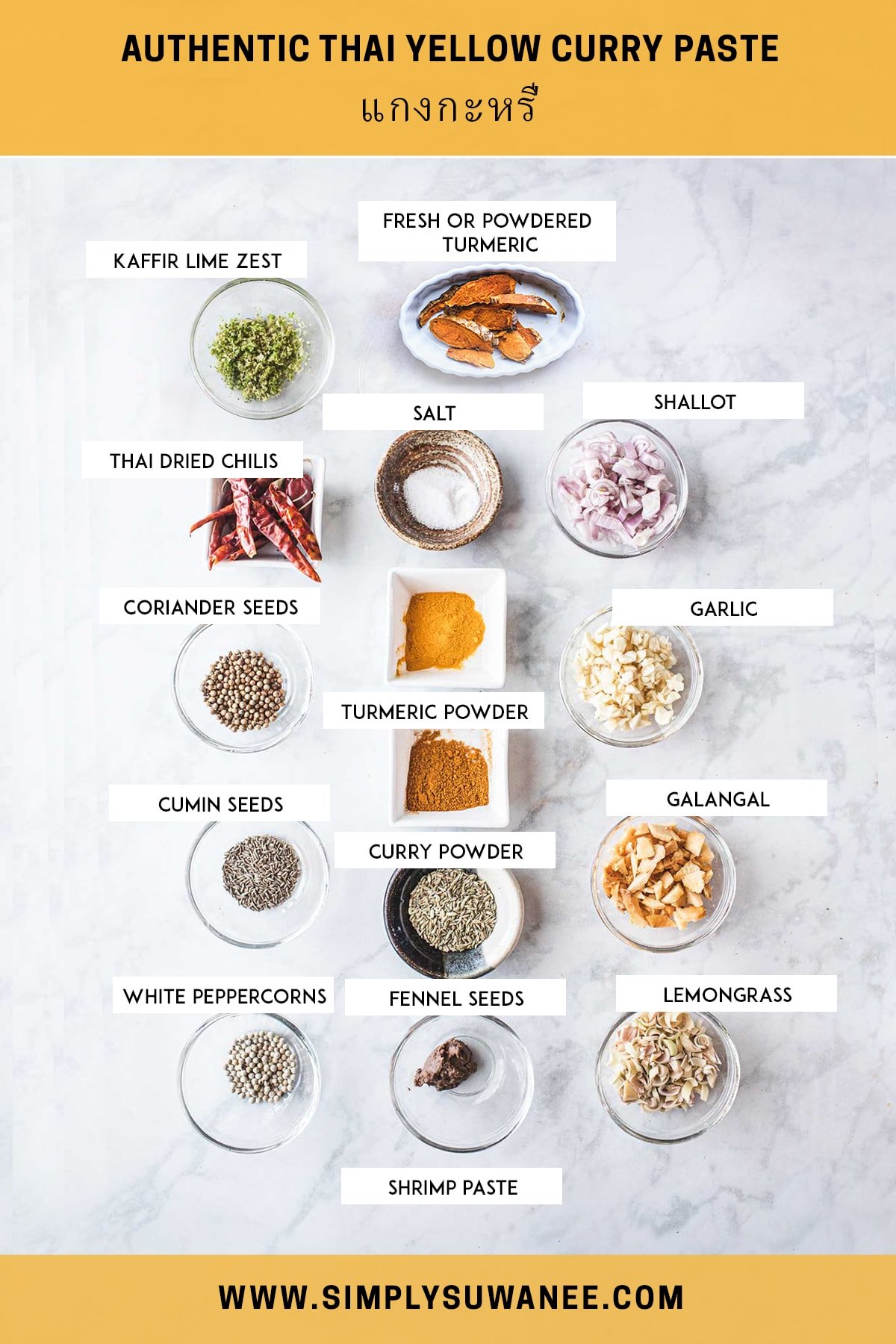
DRY SPICES
Most of these warm spices above can be found at your favorite local Asian grocery store. Using whole spices rather than ground-up is best for maximum freshness and great flavors.
- Turmeric. Turmeric is the star ingredient in this authentic Thai yellow curry paste. The ingredient gives the paste a bright yellow color and earthy flavor. My recipe uses fresh turmeric, but you can use ground turmeric powder. The powder form will give your curry an even brighter yellow color.
- Dried red chilis. There are a few red chili peppers options you can use. These are great options: Chilis for the heat in the paste, Thai bird’s eye chilis, Piri Piri chilis, long Thai chilis (Prik Chee Fah), De Arbol, or dried Serrano chilis.
- Curry powder. My recipe uses curry powder for the extra zing of flavors. Curry powder is a spice blend usually made with ground spices like turmeric, cumin, ginger, and pepper.
- White peppercorn. White peppercorns are made from ripe black peppercorn berries. Use the whole peppercorn if possible, but ground white peppercorn will work too.
- Coriander seeds. Coriander seeds are available in most Asian markets. Ground coriander powder works fine too.
- Cumin seeds. Cumin seeds add citrusy, earthy, and warmth to Thai curry pastes. Cumin powder works great too.
- Fennel seeds. Fennel seeds are a warm spice that tastes and smells similar to licorice. They look very similar to cumin seeds, be sure you grab the right ones, as they are very different.
- Salt. I recommend using kosher or Himalayan fine-grain salt. Salt is essential to make the curry paste in a mortar and pestle. It helps break down the oil of the peppers and makes it easier to crush them into a fine paste.
WET/FRESH HERBS
The remaining ingredients are the fresh spices and softer herbs needed for this recipe. Use fresh, not dried-up herbs for the best curry paste. Find these delicious ingredients t the Asian markets near you.
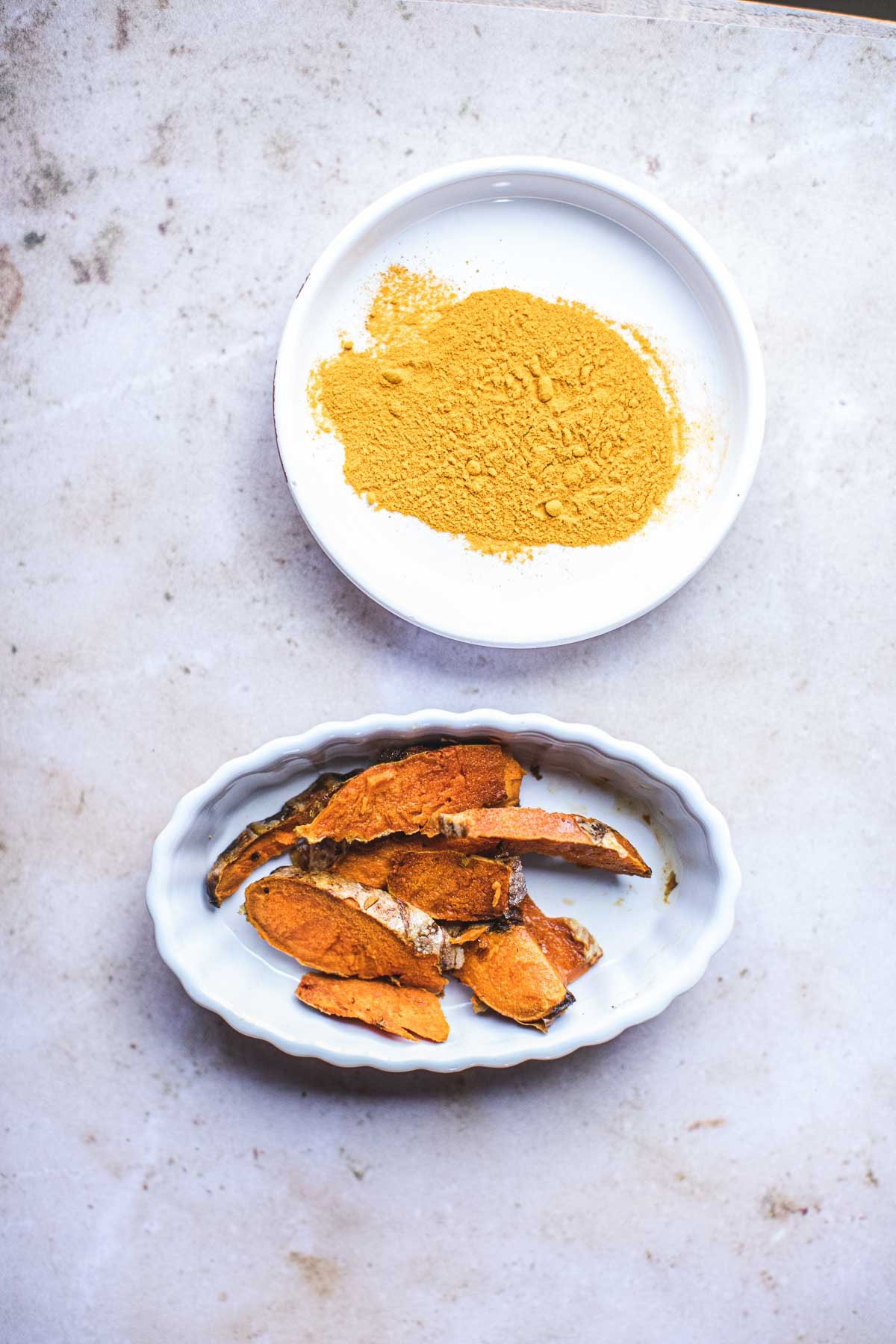
- Turmeric. You can use fresh or ground turmeric. Use less if you are using ground instead of fresh or frozen turmeric. If you find a batch of fresh turmeric, you can wash and freeze them in a glass jar for later use. They keep in the freezer for up to a year.
- Lemongrass. Use fresh lemongrass if possible, and only use the rounded 3-5 inches part of the stem. Make sure to chop your lemongrass into fine pieces before pounding to help speed up the paste-making. Use frozen lemongrass if fresh ones are not available to you. Read more about Lemongrass and how to use it in Thai cuisine.
- Galangal. Use fresh or frozen galangal only for Thai curry paste recipes. Never use dried or powdered galangal. Also, never substitute ginger for galangal; they are two completely different ingredients with different flavors and fragrances. Most, if not all, Asian markets will have fresh or frozen galangal. Read more about Galangal in Thai cooking here.
- Kaffir lime zest. This is the one ingredient you may not be able to find fresh, even in some well-stocked Asian markets. If you cannot find fresh kaffir limes, try this as a substitute. Use one lime zest plus 3-4 Kaffir lime leaves. If you can find key limes, use 3-4 key limes instead of 1 medium-sized lime. Key limes have a fragrant profile that is very nice to use as a substitute for kaffir limes. Read more about Kaffir limes and leaves and substitute here.
- Shallot. I don’t recommend substituting purple onions for making curry pastes. Shallots are typically available in most grocery stores.
- Garlic. Garlic is essential in making curry pastes. Since a lot of it is used in each batch, here is a trick to help you peel them more easily. Smash the garlic cloves with the flat side of a knife or a heavy kitchen tool like a pestle. It’s easier to peel off the garlic skin once smashed.
- Shrimp paste. I highly recommend Thai shrimp paste for a more authentic taste in your red curry paste. The smell is potent, but the paste will add a very deep umami best flavor to your curry paste.
HOW TO MAKE AUTHENTIC THAI YELLOW CURRY PASTE
I'll show you two methods for making Thai yellow curry paste. The first is super quick and easy using a food processor. It's perfect for when you want a quick homemade yellow curry.
The second way, a more traditional method when you have a little extra time and want the authentic flavors for a special dinner, is to pound all ingredients in a heavy mortar and pestle. Both methods will give you great curry pastes. It's a matter of preference and convenience. Let's grab your ingredients and make yellow curry paste!
Method 1. Using a food processor
Step 1. Remove the stems and seeds of the chilis, then soak all the chilis in warm water for 15-20 minutes or until soft. Or microwave the chilis with water on high for 3 minutes. Carefully drain the hot liquid, pat dries the chilis, and use kitchen scissors to cut the soaked chilis into 1-inch pieces and place them in the mortar.
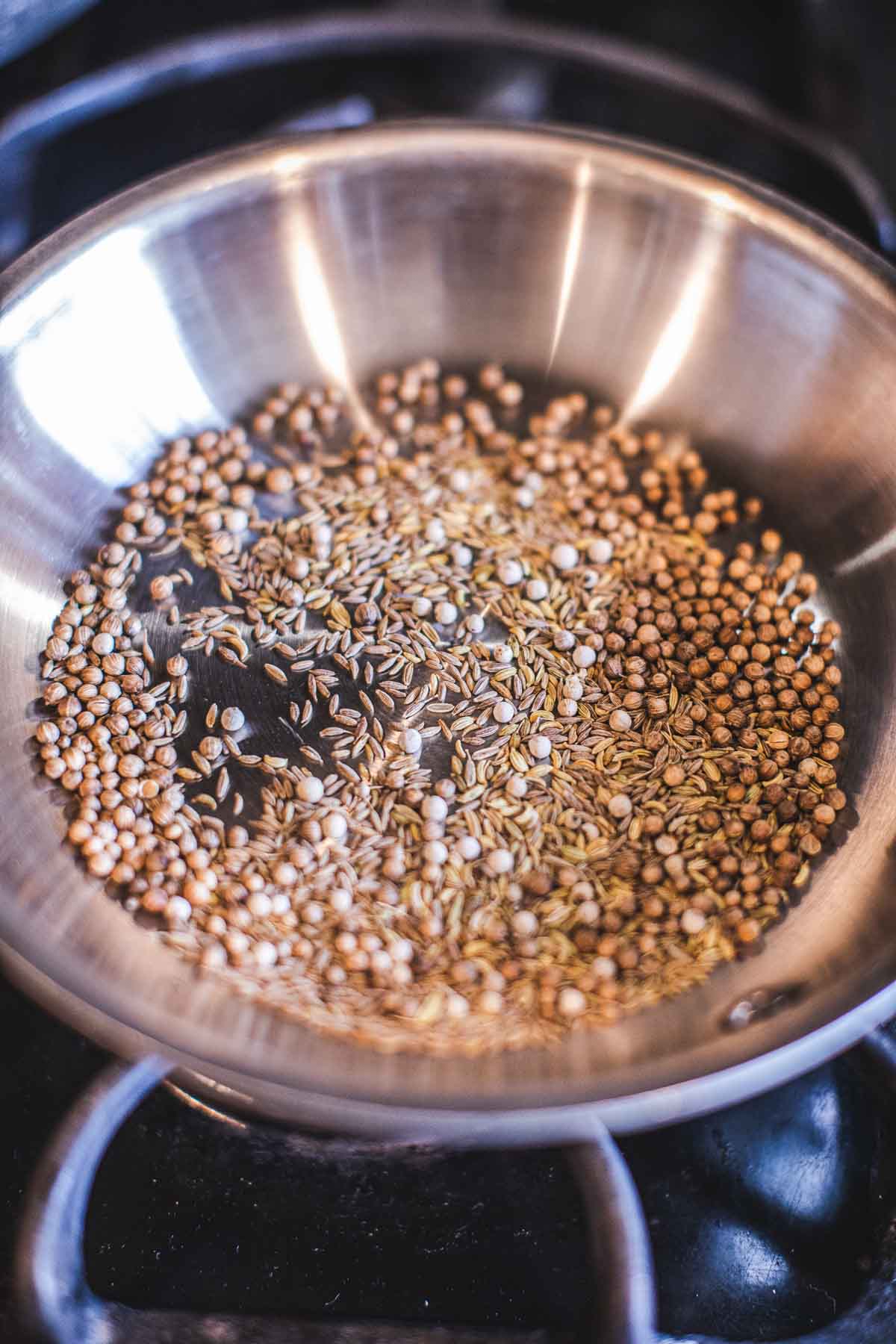
Step 2. On a small skillet, toast white peppercorn, coriander, cumin, and fennel seeds on medium heat until fragrant. Once you hear a few seeds popping from the pan, turn the heat off, remove them, and let them cool. Once cooled, use a spice grinder to turn it into powder. Set aside for pounding in a minute.
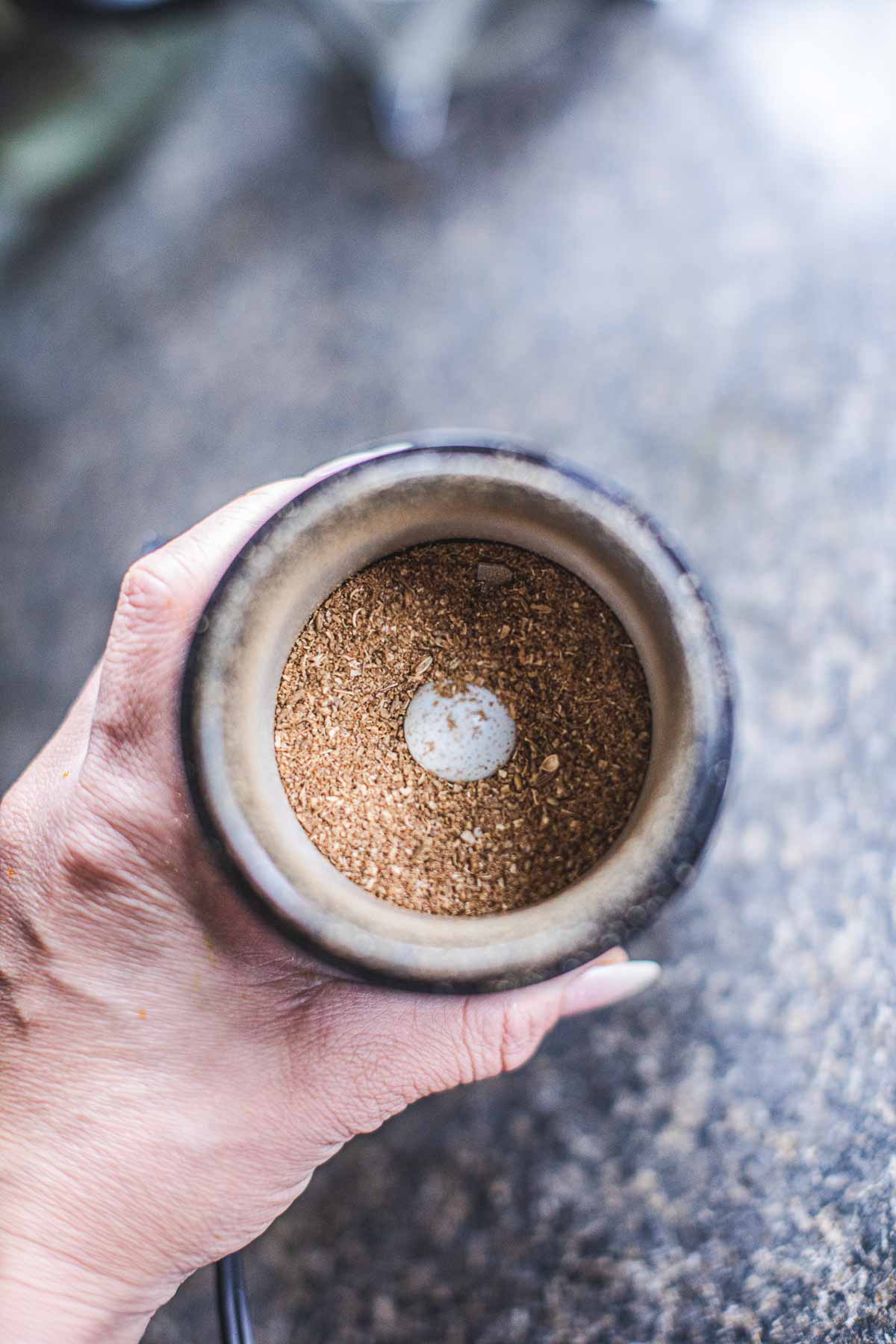
Step 3. Add all the ingredients into a small food processor and blend until a smooth paste forms. Add a very tiny amount of water if your paste is too dry. You shouldn't need to but don't use more than two tablespoons for the recipe.
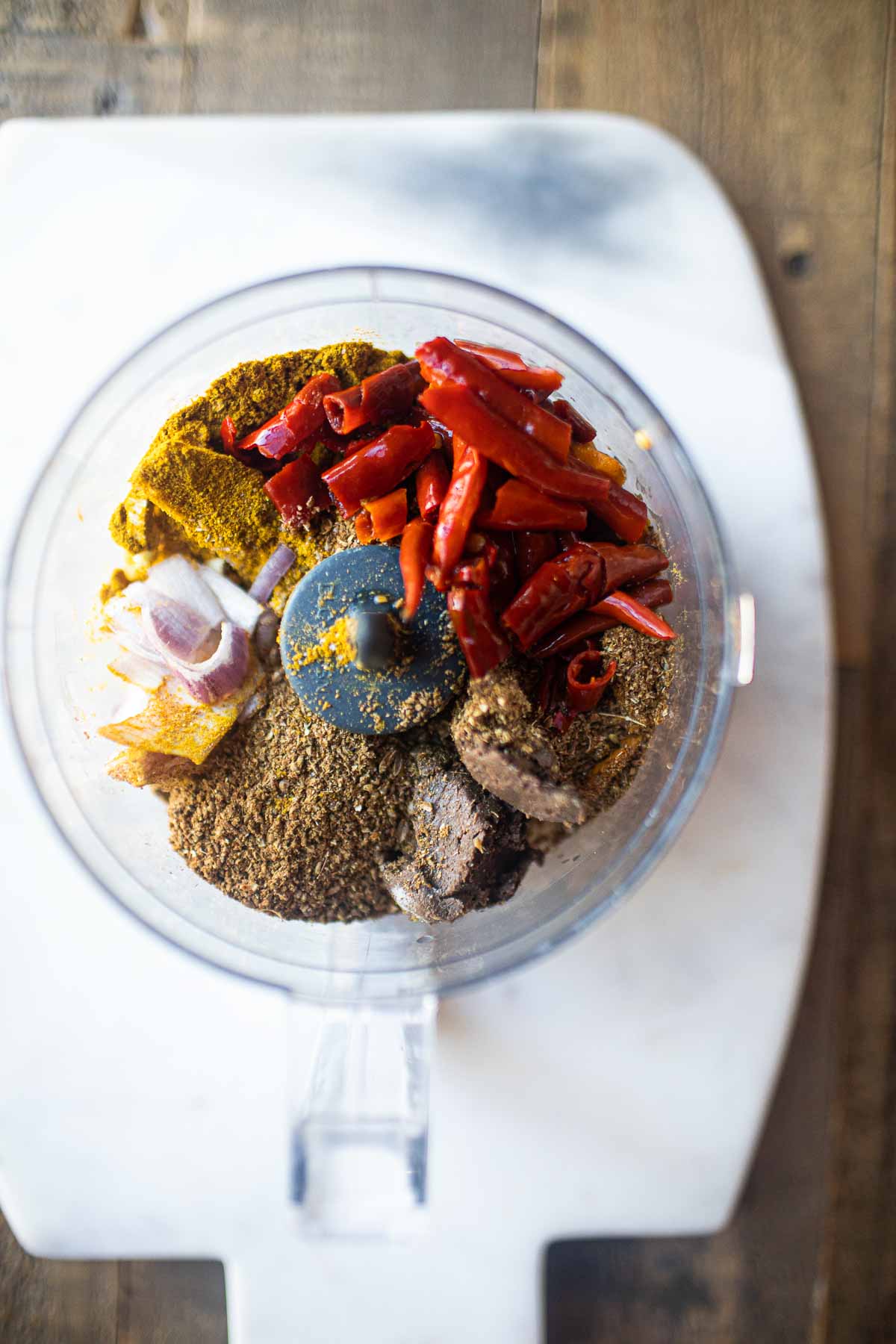
Step 4. Done! Remove the paste for use. Store unused paste in a glass jar, in the fridge for up to 10 days, and in the freezer for 4-6 months.
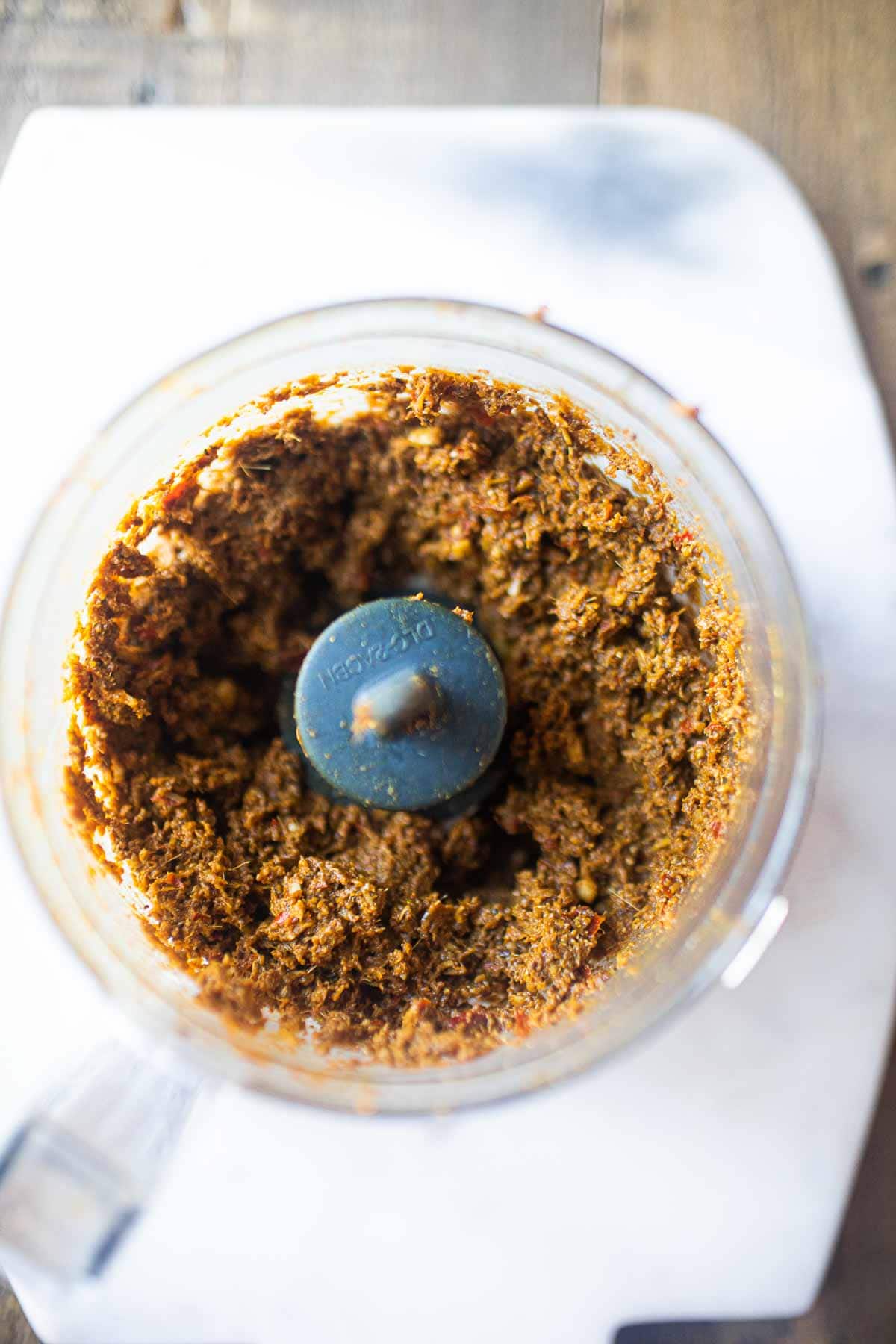
Method 2. Using a food mortar and pestle
Step 1. Remove the stems and seeds of the chilis, then soak all the chilis in warm water for 15-20 minutes or until soft. Or microwave the chilis with water on high for 3 minutes. Carefully drain the hot liquid, pat dries the chilis, and use kitchen scissors to cut the soaked chilis into 1-inch pieces and place them in the mortar.
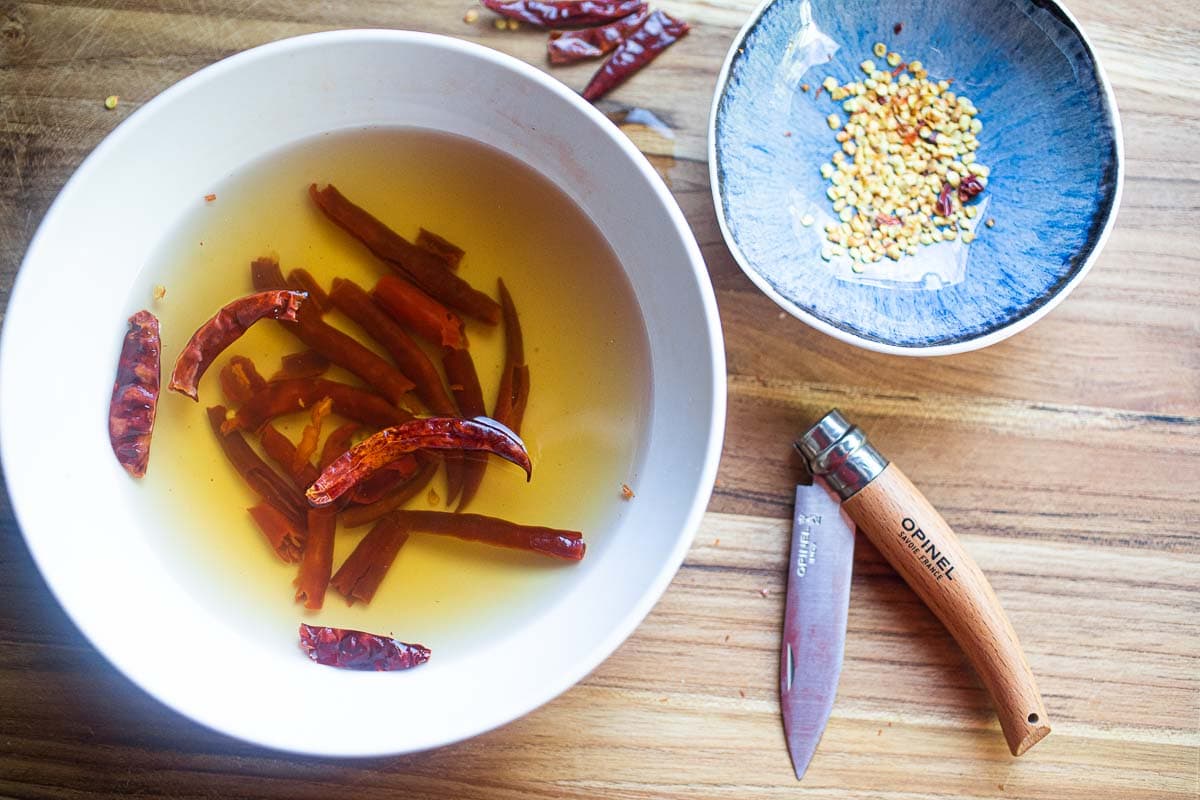
Step 2. On a small skillet, toast white peppercorn, coriander, cumin, and fennel seeds on medium heat until fragrant. Once you hear a few seeds popping from the pan, turn the heat off, remove them, and let them cool. Once cooled, use a spice grinder to turn it into powder. Set aside for pounding in a minute.
Step 3. Add the chilis and salt into a mortar and pestle and pound into a paste.
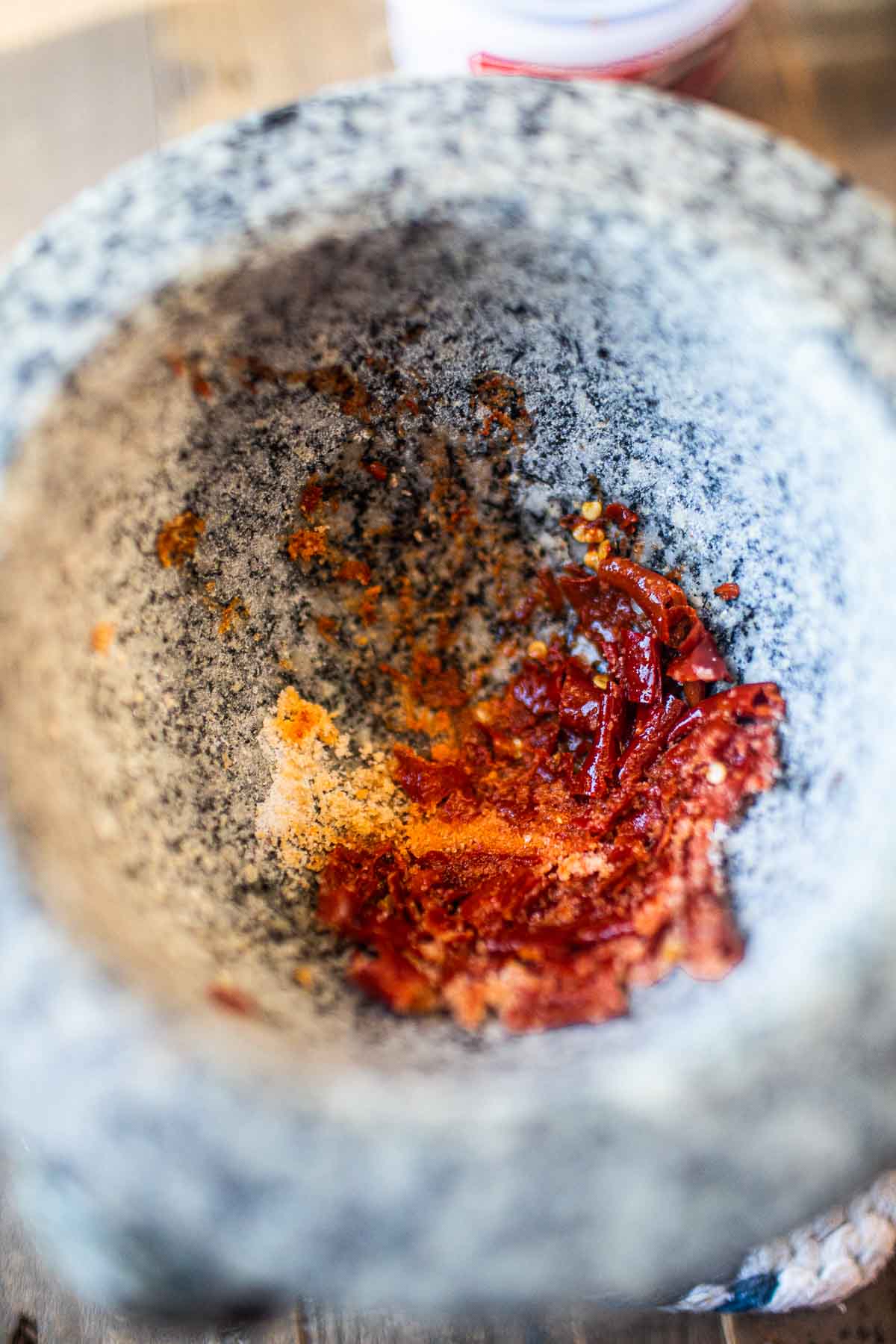
Step 4. Add galangal and lemongrass, and keep pounding until you have a smooth paste.
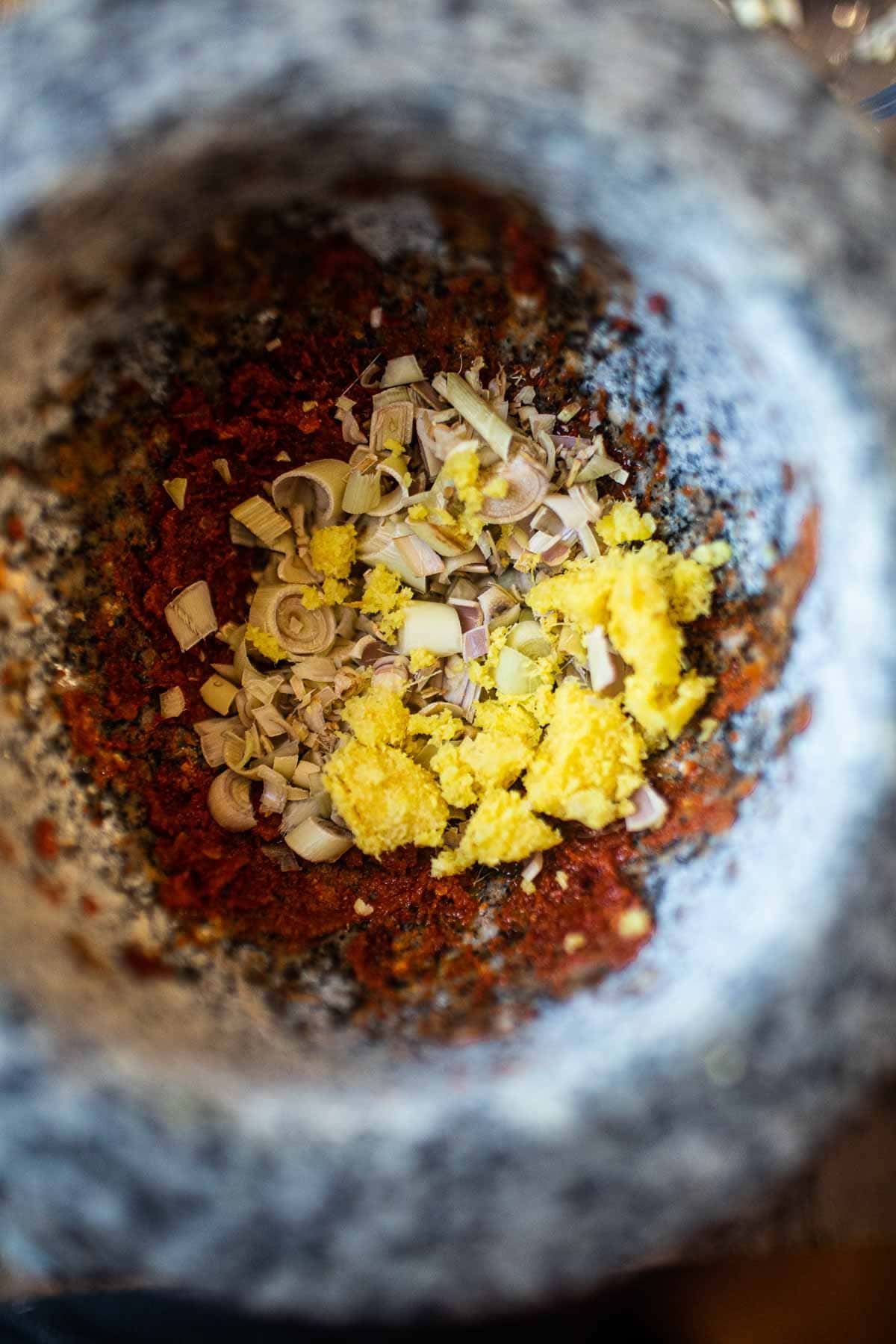
Step 5. Add garlic and shallot, and kaffir lime zest; you guess it, pound away into a paste. (;
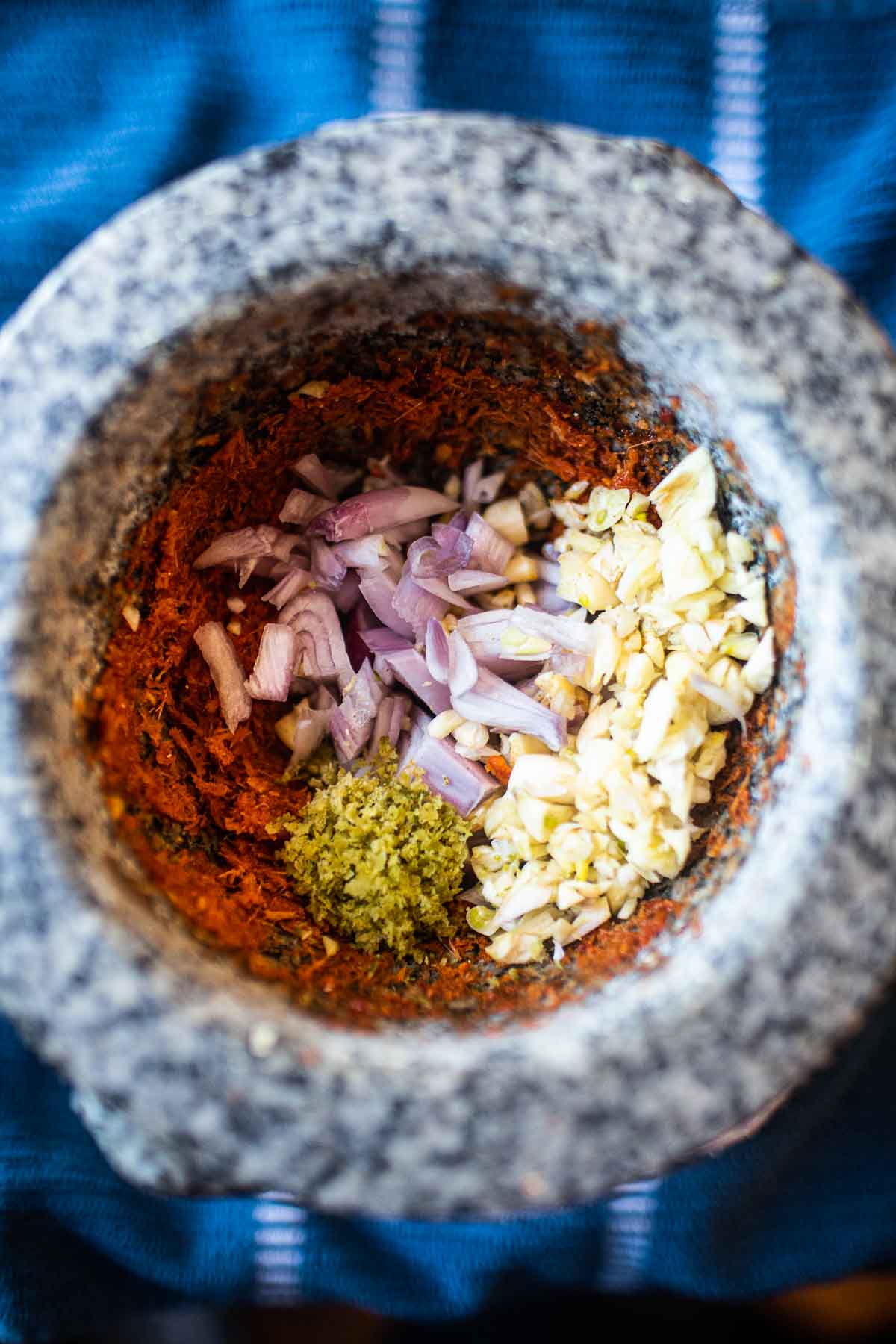
Step 6. Add turmeric and the ground toasted spices. Keep going. You're building your biceps and forearm muscles! (; Almost done!
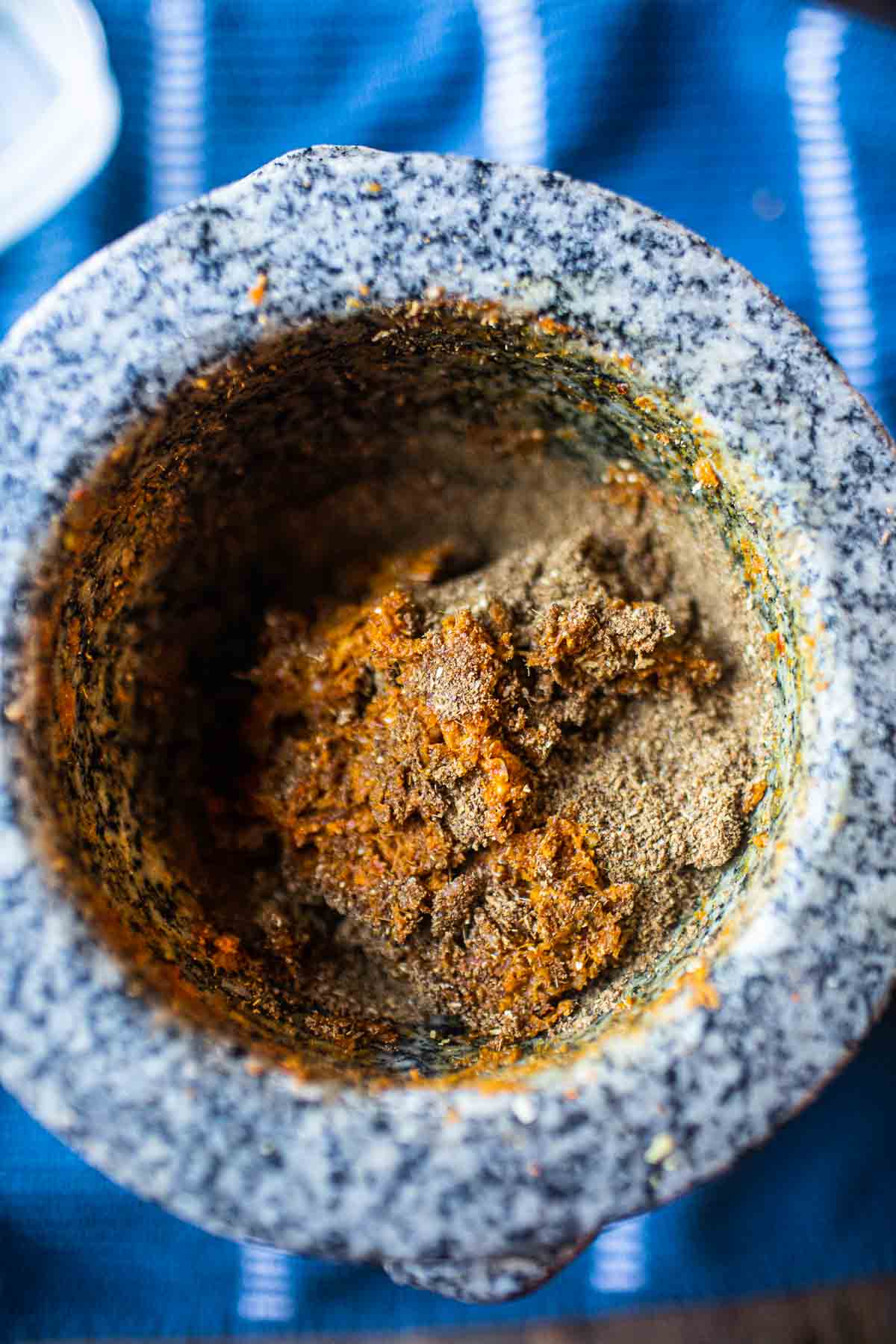
Step 7. Finally, add the shrimp paste and pound everything well until nice paste forms. Remove the paste and use it immediately for a curry. Refrigerate for up to 10 days. Refrigerate for up to 10 days. You can freeze the paste for up to 4-6 months.
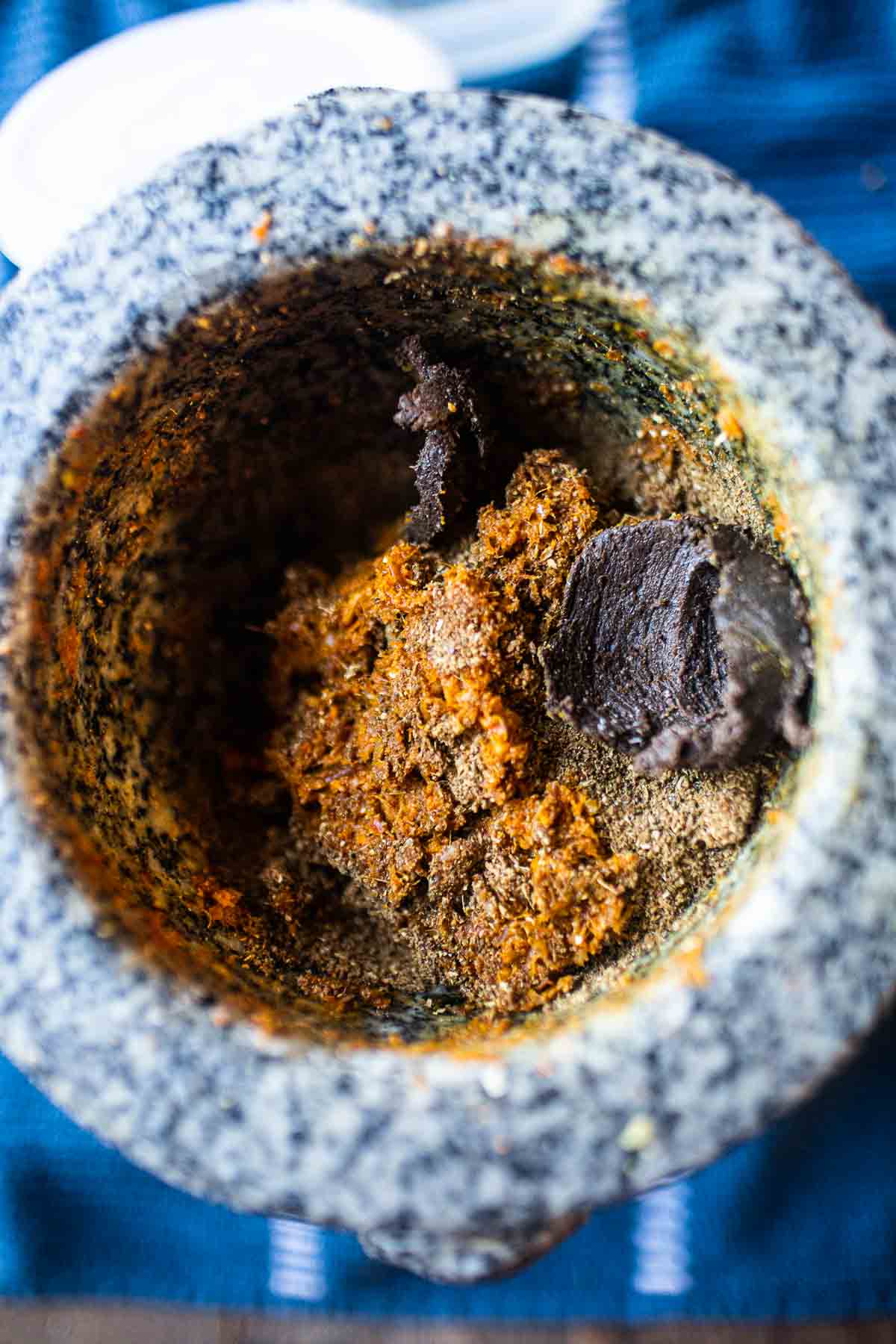
Helpful Kitchen Notes
- When handling chilis and removing the seeds, kitchen gloves are a must, or you can hurt yourself with the hot oils of the chilis burning your skin. It’s a very unpleasant experience.
- Don’t let the seeds get too burnt, or your paste will have an unpleasant bitter taste. Once a few seeds start to pop, shake the pan a few times, turn the heat off, and let it sit to cool.
- Use a solid, strong mortar and pestle to pound away the ingredients. It’s an arm workout to make curry paste the traditional way. Make sure you don’t use clay, marble, wooden, or decorative mortar and pestle for this job.
- Best not to pound more than three ingredients at a time as it gets tiresome to pound in large quantities. Also, you may have big chunks of uncrushed ingredients if adding too many items.
- Always pound the toughest and most fibrous ingredients first, as listed in the steps above and the recipe card.
- Add the shrimp paste last. It’s the softest ingredient for the paste, and if added too soon, I find it more difficult to pound the ingredients into a paste because it's too wet and slippery.
- Shrimp paste is a must for the traditional umami flavors that ties all the strong spices and herbs together. Don’t skip out if you can help it!
- Using a smaller mortar and pestle, you can break up your paste into smaller 2-3 batches to ease pounding the ingredients together. Add them all together in a bowl for the final finished paste.
More homemade curry pastes you'll love
Try these different types of Thai curry pastes at home. These are healthy recipes full of healing herbs and spices that Thai food is known for! Give them a try.
- Authentic Thai yellow curry paste
- Authentic green curry paste
- Choo Chee curry paste
- Red Thai curry paste
- Tom Yum paste
Variations
You can make this homemade Thai yellow curry paste recipe into a vegan yellow curry paste! The best substitute I've found is to use vegemite, a brown paste made from yeast.
Storage
Store your homemade yellow curry paste in an airtight container in the fridge for up to 2 weeks and up to 4-6 months in the freezer. For smaller quantities, separate the paste and freeze it in ice cube trays for a smaller and easier measurement.
Substitution
If you love Thai yellow curry and absolutely don't have time to make your paste, my go-to paste is the Mae Ploy brand. I find that Mae Ploy yellow curry paste has the most concentrated curry paste flavors out of all the brands out there.
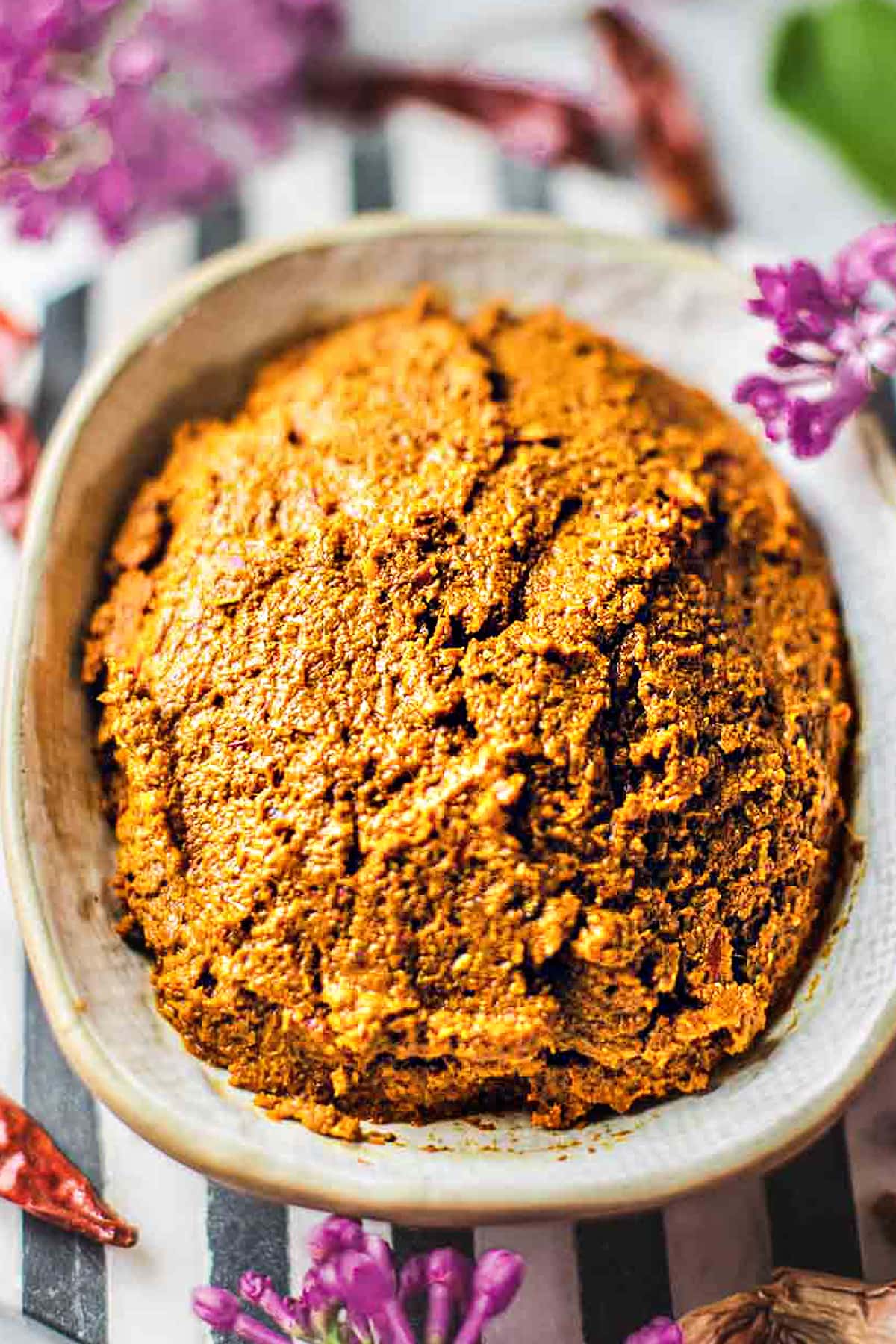
FAQs
Use the freshest ingredients to make your homemade Thai curry paste better. I like to make my paste in the summer when fresh ingredients are in season. Make a big batch of your favorite curry pastes and freeze them for use in the winter months for making curries.
There are many great Thai curry pastes in Thai cuisine. The main ones are red, green, yellow, massaman, Penang, prik khing, jingle, choo chee, and so much more! Check out my recipe links, and stay tuned for a few more!
Yellow curry is made from yellow curry paste. The paste is made with dried red chilis, turmeric, shallot, garlic, several fragrant spices, and a few other Thai ingredients processed into a bold, bright, tasty yellow curry paste used in Thai cooking.
More Thai curries you'll love!
- Thai pork belly with yellow curry
- Authentic Thai green curry paste
- Thai red curry with chicken and pineapple
- Authentic homemade Thai red curry paste
- Easy Thai yellow curry recipe with chicken
- Authentic Thai red curry recipe
** Love a recipe you've tried? Please leave a 5-star ?rating in the recipe card below and/or a review in the comments section further down the page. Or follow me on Facebook, Pinterest, or Instagram! **
Print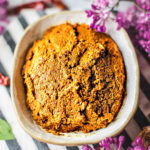
Authentic Thai Yellow Curry Paste, แกงกะหรี่
- Total Time: 30 minutes
- Yield: 1 cup
- Diet: Low Calorie
Description
Making authentic Thai yellow curry paste is more simple than it sounds. The bright yellow color with the bold taste of the curry paste requires a few aromatic spices, fragrant herbs, and Thai seasonings to give your homemade paste the most delicious and fresh for your Thai curry recipes.
Ingredients
- 5-10 long dried chilis, deseeded & stems removed (wear gloves when handling hot chilis).
- 2 teaspoon salt
- 2 teaspoon whole white peppercorn
- 2 tablespoon coriander seeds
- 1 tablespoon cumin seeds
- 1 tablespoon fennel seeds
- 1 tablespoon curry powder
- 3 tablespoon fresh turmeric or 1 ½ tablespoon turmeric powder
- 1 tablespoon galangal, chopped small
- 2 ½ tablespoon lemongrass, finely chopped
- 3 tablespoon garlic, chopped small
- ⅓ cup shallot, diced small
- 1 tsp kaffir lime zest or *substitute* ½ teaspoon regular lime zest + 1 kaffir lime leaves
- 1 tablespoon shrimp paste
- ½ -2 teaspoon water *as needed only
Instructions
Using a food processor
- Remove the stems and seeds of the chilis, then soak all the chilis in warm water for 15-20 minutes or until soft. Or microwave the chilis with water on high for 3 minutes. Carefully drain the hot liquid, pat dries the chilis, and use kitchen scissors to cut the soaked chilis into 1-inch pieces and place them in the mortar.
- On a small skillet, toast white peppercorn, coriander, cumin, and fennel seeds on medium heat until fragrant. Once you hear a few seeds popping from the pan, turn the heat off, remove them, and let them cool. Once cooled, use a spice grinder to turn it into powder. Set aside for pounding in a minute.
- Add all the ingredients into a small food processor and blend until a smooth paste forms. Add a very tiny amount of water if your paste is too dry. You shouldn't need to but don't use more than two tablespoons for the recipe.
- Remove the paste for use. Done! Store unused paste in a glass jar, in the fridge for up to 10 days, and in the freezer for 4-6 months.
Using a food mortar and pestle
- Remove the stems and seeds of the chilis, then soak all the chilis in warm water for 15-20 minutes or until soft. Or microwave the chilis with water on high for 3 minutes. Carefully drain the hot liquid, pat dries the chilis, and use kitchen scissors to cut the soaked chilis into 1-inch pieces and place them in the mortar.
- On a small skillet, toast white peppercorn, coriander, cumin, and fennel seeds on medium heat until fragrant. Once you hear a few seeds popping from the pan, turn the heat off, remove them, and let them cool. Once cooled, use a spice grinder to turn it into powder. Set aside for pounding in a minute.
- Add the chilis and salt into a mortar and pestle and pound into a paste.
- Add galangal and lemongrass, and keep pounding until you have a smooth paste.
- Add garlic and shallot, and kaffir lime zest; you guess it, pound away into a paste. (;
- Add turmeric and the ground toasted spices. Keep going. You're building your biceps and forearm muscles! (; Almost done!
- Finally, add the shrimp paste and pound everything well until nice paste forms. Remove the paste and use it immediately for a curry. Refrigerate for up to 10 days. Refrigerate for up to 10 days. You can freeze the paste for up to 4-6 months.
Notes
- When handling chilis and removing the seeds, kitchen gloves are a must, or you can hurt yourself with the hot oils of the chilis burning your skin. It’s a very unpleasant experience.
- Don’t let the seeds get too burnt, or your paste will have an unpleasant bitter taste. Once a few seeds start to pop, shake the pan a few times, turn the heat off and let it sit to cool.
- Use a solid, strong mortar and pestle to pound away the ingredients. It’s an arm workout to make curry paste the traditional way. Make sure you don’t use clay, marble, wooden or decorative mortar and pestle for this job.
- Best not to pound more than three ingredients at a time as it gets tiresome to pound in large quantities. Also, you may have big chunks of uncrushed ingredients if adding too many items.
- Always pound the toughest and most fibrous ingredients first, as listed in the steps above and in the recipe card.
- Add the shrimp paste last. It’s the softest ingredient for the paste, and if added too soon, I find it more difficult to pound the ingredients into a paste because it's too wet and slippery.
- Shrimp paste is a must for the traditional umami flavors that ties all the strong spices and herbs together. Don’t skip out if you can help it!
- Using a smaller mortar and pestle, you can break up your paste into smaller 2-3 batches to ease pounding the ingredients together. Add them all together in a bowl for the final finished paste.
- You can turn a Thai yellow curry paste recipe vegetarian or vegan by vomiting the shrimp paste and instead using vegemite or marmite.
** Thank you so much for visiting my blog! This is truly a passion for me. If you have enjoyed these recipes and appreciate the hard work I put into them, I would love it if you would share them with your friends! Your recommendation is the highest review I could hope for, and I’d so appreciate it! **
- Prep Time: 15
- Cook Time: 15
- Category: Curries
- Method: Food processor
- Cuisine: Thai

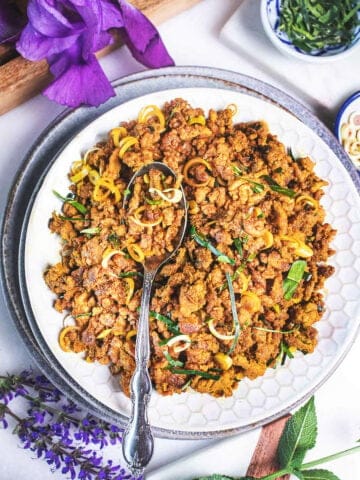
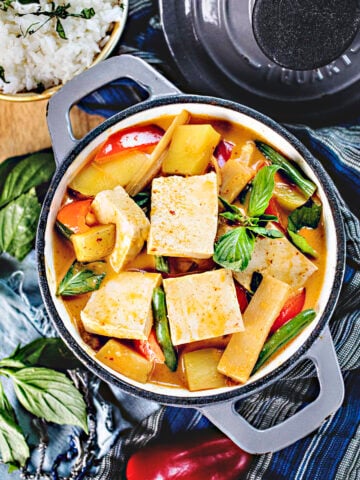
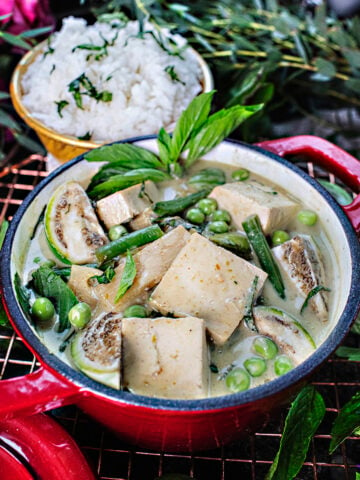

Leave a Reply